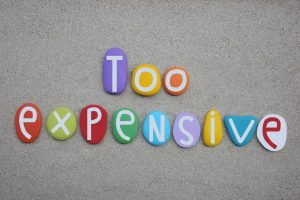
You’ve followed your sales training up to the point where you believe you have a solid prospect.
They ask for a proposal.
You send them a proposal.
The response?
“It’s too expensive.”
“The price is too high for that.”
“I can’t believe you’re charging that much.”
You’re either angry at the client or begin to doubt yourself.
Instead…remember what the objections are really about.
The real obejctions
They’re not actually about the dollars.
They are about the three things missing from your proposal or your offer.
How will this change my life?
#1- The buyer is missing any sense of how their life will change for the better when they buy what you’re offering.
I talk about life changing differences a lot.
What do I mean?
The simplest meaning is that you relieve the buyer of a problem.
They were missing something, didn’t have something, were afraid, sad, worried, and so on. When you end this problem, you’ve changed their life.
Instead of offering to DO something for a price talk about how they’ll get a life changing impact for that price.
How does this price compare to others?
#2 – The buyer is missing any context for that price.
Context means describing other options and their prices. When you make a take-it-or-leave it offer, the only context they have is not doing anything, which costs them nothing.
They weigh your price against $0.00. Of course it seems too high!
The solution is to always give three options.
The middle one delivers exactly what they asked for. Let’s say you price it at $1000.00. The highest one will deliver additional impacts you know are possible because of your expertise, and you charge $1600.00. The lowest option is less than they asked for $850.
(My rule of thumb is +60% for the highest and -15% for the lowest.)
Now the buyer has context. He or she can calculate what they’d gain from the highest option and what they’d lose from the lowest and get a sense that the middle options—what they really want—is priced just right.
Can I feel confident about my decision?
#3- The buyer is missing confidence that they’ll be making a good decision.
Confidence theory says that people have more confidence in their decisions when they’ve chosen from options. They do not have to believe the seller—who is always confident and has self interest.
Three options mean the buyer can do their own evaluation and calculation and weigh the pros and cons in their own mind and according to their own values.
Once they’ve done this and made a choice, they have confidence their choice is right.
When you only offer one option, they can’t do this analysis and so they feel most confident continuing to do what they’ve been doing rather than buying from you.
Don’t wait until a prospect—or a current client with new needs—complains about your price.
It’s too late then.
Three Options
Instead, commit to making three options no matter what!
Even in instances where it seems there aren’t three options, look harder and design them. You know what a bigger life changing difference can look like, and you know what smaller one can look like.
Write your proposal with the options listed from highest to lowest.
Use words like IMPACT PLUS, IMPACT, IMPACT Light.
Some of my clients have other names. One uses Universal, Comprehensive, Core. Another uses Scale, Growth, Core.
The buyer is very likely to choose one of the options because they see life changing differences, they have context, and they have confidence.
Make 2024 your year of IMPACT Based Pricing
Many companies use the end of the year to investigate and choose major changes for the coming year.
If you’re going to make one big change, make it to your pricing model. Don’t let 2024 be a copy of 2023.
Choose IMPACT Based Pricing and the Choice Framework. 2024 will be an awesome year.


